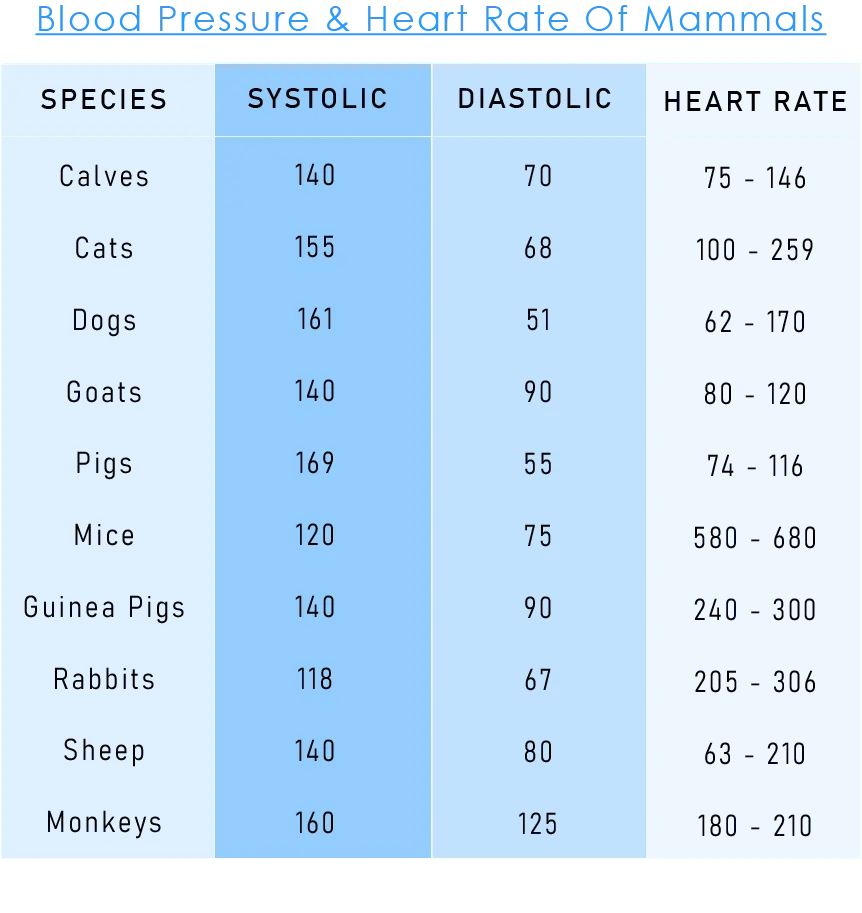Blood Pressure Chart for Mammals

A comprehensive blood pressure chart for mammals, presenting normal ranges of blood pressure readings across various Mammalian species.
Maintaining Healthy Blood Pressure in Mammals: Diet, Exercise, and Care Tips
Blood pressure in mammals, including humans, plays a crucial role in maintaining proper circulation and delivering oxygen and nutrients to the body’s tissues. While specific blood pressure ranges can vary among different mammalian species, the principles of maintaining healthy blood pressure are generally similar. Here are some key points:
1. Diet and Nutrition:
- Provide a balanced and species-appropriate diet for the mammal, considering their nutritional needs.
- For herbivorous mammals, ensure a diet rich in fiber, fresh greens, and appropriate forage.
- For carnivorous mammals, offer high-quality proteins and appropriate sources of fats.
- Avoid excessive salt/sodium intake, as it can contribute to high blood pressure. Consult with a veterinarian to determine the best dietary plan for the specific mammal.
2. Regular Exercise:
- Promote regular physical activity suitable for the mammal’s species and age.
- Exercise helps maintain a healthy weight, improve cardiovascular fitness, and regulate blood pressure.
- Provide ample opportunities for mammals to engage in natural behaviors and physical activities that suit their species.
3. Stress Management:
- Minimize stressors and create a calm and enriched environment for the mammal.
- Avoid situations that may cause excessive stress or anxiety.
- Provide mental stimulation and outlets for natural behaviors, such as environmental enrichment and interactive toys.
4. Regular Veterinary Check-ups:
- Schedule regular check-ups with a veterinarian to monitor the mammal’s overall health, including blood pressure assessments if necessary.
- A veterinarian can identify any potential health issues and provide appropriate guidance and treatment if needed.
It’s important to note that maintaining healthy blood pressure in mammals requires a comprehensive approach tailored to the specific species, age, and individual needs of the animal. Consulting with a veterinarian who specializes in the particular mammal species is essential for personalized guidance and recommendations based on their expertise and knowledge of the animal’s health.
Always prioritize the well-being and health of the mammal by providing a suitable environment, proper nutrition, regular veterinary care, and appropriate exercise opportunities.
Frequently Asked Questions
What is a blood pressure chart for Mammals?
A blood pressure chart for mammals is a numerical representation that displays the range of normal blood pressure values observed in different mammalian species. It serves as a reference tool to assess and compare blood pressure readings in various mammals.
How is blood pressure measured in mammals?
Blood pressure in mammals is typically measured using non-invasive methods, such as Doppler ultrasound or oscillometric devices. These techniques involve placing a cuff or probe on a limb or tail to detect the arterial blood flow and calculate the systolic and diastolic pressures.
Why is a blood pressure chart important for mammals?
A blood pressure chart for mammals is important because it helps veterinarians, researchers, and animal caregivers monitor the cardiovascular health of different mammalian species. By comparing blood pressure readings to the established normal range, abnormalities or potential health issues can be identified.
What are the common mammalian species included in a blood pressure chart?
A blood pressure chart for mammals may include a range of species such as dogs, cats, horses, cattle, pigs, rabbits, rodents, primates, and other domestic or wild animals commonly encountered in veterinary medicine and research.
Can a blood pressure chart help in monitoring the effects of medication or treatment?
Yes, a blood pressure chart can be useful for monitoring the effects of medication or treatment in mammals. By tracking blood pressure over time, veterinarians can assess the effectiveness of prescribed medications or interventions and make adjustments as necessary.
Are there any factors that can affect blood pressure in mammals?
-
Yes, several factors can influence blood pressure in mammals. These include age, breed, size, weight, stress levels, activity levels, underlying health conditions, and medication usage. It’s important to consider these factors when interpreting blood pressure readings and consulting with a veterinarian.
